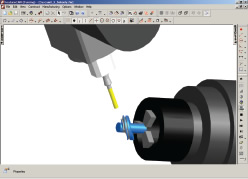November 9, 2007
By Al Dean
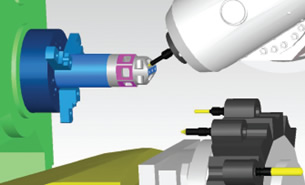 FeatureCAM 2008 has been certified for use with Autodesk Inventor. |
The CAM world is a fragmented one, particularly when compared with the CAD world. The wildly diverse and numerous applications available to create usable NC code from a design and load it onto a machine tool proves that this is an industry in which there are many requirements — and often these are requirements that don’t overlap.
Even if you start to categorize CAM applications, you’ll see the spread. Start with 3-axis high-speed machining and move up to six axes and more, and I can think of around 15 or 20 players in the market off the top of my head. These typically handle complex parts, control complex machines, and are driven by 3D CAD geometry. What about the other end of the spectrum?
The 2D-defined parts, those parts that require less-complex programming for use on 2- and 2.5-axis machines, or up to three axes. What’s available here? The answer, surprisingly, is very little. Particularly if you want to start out with basic turning or machining, then use the same system and interface to move up to more complex forms of machining.
One solution that does come to mind is FeatureCAM from Delcam. While Delcam’s name is synonymous with high-speed and multiaxis machining for the mold-and-die industry, the company has also, through acquisition, begun to broaden its horizons and process coverage. The FeatureCAM product range is a good example — so let’s walk through the basics of the system and look at exactly what it can do for you.
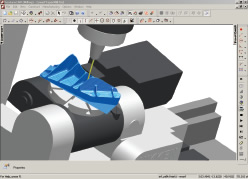 FeatureCAM 2008 includes support for swarf machining, which can be used to machine aerostructures. |
|
A good starting point is the user interface (UI). The FeatureCAM UI is geared around building NC code from scratch, or at least from a 2D CAD drawing. The concept, unlike many other CAM tools, is that you’re given a basic sketch or technical drawing — and you need to manufacture it. The system can be driven by a wizard that assists with getting things set up, or you can do it manually. FeatureCAM has several modules, covering 2.5-axis, 3-axis, multiaxis work, Wire EDM, and others. The wizard will guide you through the setup steps appropriate to your task (usually stock or billet setup and material selection, which links to a feeds and speeds database) and machining operation type and present you into the UI.
To the left is the Part View browser. This is a structured tree that gives you access to everything within your part, from stock model and setup files to curves, surfaces, and solids. The central portion of the UI is taken up with the viewing window, which shows the geometry on which you’re working. To the right is the Result window, which holds the toolpaths you create, but we’re getting ahead of ourselves.
The FeatureCAM concept is that it provides you with all the tools you need to either import data from 2D sketches or 3D CAD geometry or, at the very lowest level, to sketch geometry from scratch. The system includes all of the tools you’d need to create profiles and geometry of a part for machining, then define the specifics of those operations. There are also a number of built-in features that can be indentified in your parts, such as hole, groove, thread, face, cut off, bar feed, and bore. Whether you use these or create them from scratch, as you define each, you click the Simulation button to check the toolpath and create the NC code. The driving concept behind FeatureCAM is reuse. You spend the time upfront to decide how you want certain materials, certain features or operations to work, then reuse that information with each job, rather than programming each from scratch.
Once each operation is complete, it’s added to the Result window. What’s of interest here is that as you add the operations to the Results panel, the system looks at each feature and can re-order it automatically to minimize tool changes, reduce rapid-moves, height, etc. You can also switch this off and order the operation list by hand to achieve the results you want.
While we’ve discussed basic milling and turning based on 2D geometry, FeatureCAM of course supports much more sophisticated data sources and manufacturing processes. In terms of Mill and Turn support, FeatureCAM handles synchronization of spindles as well as machines with upper, lower, and subturrets. It provides all of the tools you need to truly make the most of such hardware by allowing you to optimize its use — for example, as one part on the primary spindle is finished and passed over, you can continue to use your subspindle to finish the other side of that part while another is being prepared.
When you’re handling 3D data, the system uses the same principles, but applies them to the richer description available in 3D geometry. In terms of format support, it brings in IGES and AutoCAD (both DWG and DXF) data as default. There are then additional options for the import of Parasolid, ACIS, SolidWorks, Inventor, Solid Edge, CATIA V4 & V5, Pro/ENGINEER, and Unigraphics.
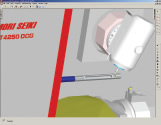 Extra postprocessors have been added toFeatureCAM 2008 for mill-turn machines. | 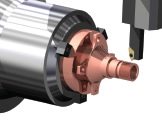 FeatureCAM 2008 allows more efficientprogramming of turning operations. |
When you import the data using the FeatureRecognition module, the system will automatically assign the stock model size and identify any features (holes, pockets, etc.) it finds and present them as a list. You can keep these or override some to create your own.
We started out by looking at the machining world and the CAM systems that operate within it. Yes, there are several classes of CAM application out there and interestingly Delcam seems to now operate in all of them. While its flagship product, PowerMill, gives you all of the tools and techniques you need within the mold-and-die industry, Delcam’s FeatureCAM differs in entirely good ways. FeatureCAM offers a way to take typically less complex parts and create the NC code you need to machine them in a very short space of time. It does it with intelligence to ensure that you’re making the best of your machine tool — and when it comes to manufacturing-focused software, can you really ask for anything more?
More Information
FeatureCAM 2008
Delcam
Birmingham, UK
delcam.com
Al Dean is technology editor at MCAD Magazine, a UK product development and manufacturing technology journal (mcadonline.com) and is editor of Prototype magazine (prototypemagazine.com). You can send comments about this article to DE-Editorsmailto:[email protected].
Subscribe to our FREE magazine, FREE email newsletters or both!
About the Author
DE’s editors contribute news and new product announcements to Digital Engineering.
Press releases may be sent to them via [email protected].







